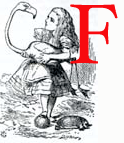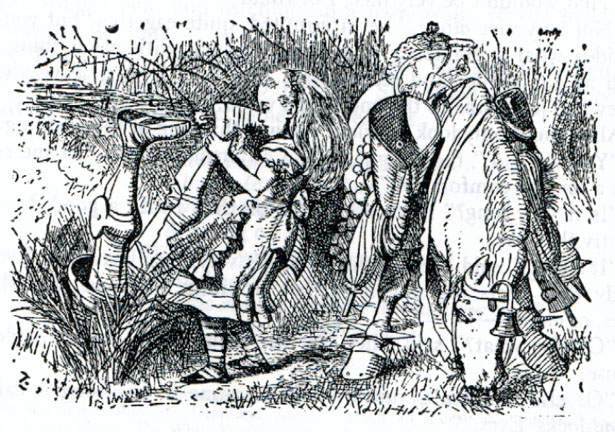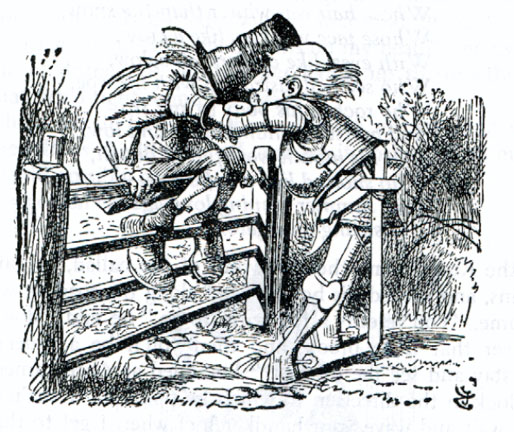
rom earliest childhood Lewis Carroll was his mother's adored "Charlie," her first-born male child. He was home-schooled to the age of eleven in a highly educated rural environment where he easily imbibed the poetry of the English Romantic Movement. The lasting effects of such an idealised "one to one" mental and personal stimulation may be gleaned from Carroll's prolific writings in later life. In particular, for the present purpose, examples of the influence of these early years can be found in his second major children's story, Through The Looking-Glass. Chapter VIII ("It's My Own Invention") shows him drawing on them, as he makes subtle but calculated efforts to hide, disguise and thereby maintain and remember quite privately his own youthful experiences of first and unrequited love. Such life-changing events, we should note, occurred before his first meeting with the young Oxford girls who would later inspire the books that made him famous.
His techniques come from various sources. Like so many Victorian children, in early childhood Carroll read the work of an author whose own literary disguises had been required for survival in harsher times of religious and political oppression — John Bunyan. Bunyan's grandly allegorical The Pilgrim's Progress (1678) provided him with not only an acceptable religious and moral compass, but also a literary technique, a veritable Gospel in "Types, Shadows and Metaphors" (Bunyan: 4). Such was its lasting impact that, in the summer of 1862, whilst assisting his friend and Christ Church contemporary William Ranken at the latter's rural church services, Carroll would incorporate readings from The Pilgrim's Progress (See Carroll, Diaries, 4: 74 passim).
In early life too, Carroll's local church in Daresbury, Cheshire, gave him opportunities to study the clever use of acrostics with their hidden messages carved into the church walls. Acrostics with their hidden agenda would subsequently be employed in most of the major publications of Lewis Carroll - and in book gifts, presentation copies and elsewhere, enabling him to hide the name of a favoured child friend, for example in his characteristic opening frame-poems. As with any competent cryptographer, the technology must reflect progress against counter-analysis/decryption over time. The typical elementary "first letter" acrostic of his early Alice's Adventures in Wonderland of 1865 - to Alice Pleasance Liddell - began "A boat beneath a sunny sky…." By 1893 in his Sylvie and Bruno Concluded his more evolved technique had become a "third letter" acrostic, beginning with "Dreams…." to his child-friend Enid Stevens.
In Chapter VIII of his second published Alice book we find Carroll treading his usual delicate tight-rope between the opposing forces of agendas and sub-agendas with their varying degrees of concealment and announcement — because the loved one at least must not be left in ignorance as to the intended message. To this end he appears to have employed both his own narrative, and his directions to John Tenniel for the accompanying illustrations. For the chapter's lengthy nonsense poem, which the White Knight sings to Alice, he tells her that "The name of the song is called 'Haddocks' Eyes.'". His subsequent involvement of the hapless Alice in a series of logical and semantic subtleties regarding degrees of "is called," "really is" and "the name is," reflects a veritable master class of pre-digital encryption. This produces no fewer than four known titles for his song, announced by Carroll as "It's my own invention," as also for the title of the chapter. However, with a late and further deep level of concealment, the Knight claims the tune also to be his own invention. Here, however, the knowledgeable Alice readily detects that in fact "the melancholy music of the song" had been borrowed from I give thee all, I can no more. The true composer of this flute duet was Thomas Moore (1779-1852), who named it My heart and lute, the first line of which corresponds to the popular admonition known to Alice and her generation. With this expert ploy of allowing his young heroine to apparently expose an error of the older man, Carroll attains a further level of concealment: that of distraction, as with the conjuror and card-sharp, who display prominently a minor effect of one hand, whilst covertly employing the other hand to greater effect. Conjuring and card-tricks were popular Victorian pastimes, and drew Carroll's attention and reporting on a number of occasions, (see Carroll, Letters I: 9 (November 1853, to his sister Mary); and Diaries 6: 249, from the Hatfield House New Year's Party on 1 January 1873).


Left: The Battle between the Red and White Knights. Right: The White Knight Falling off His Horse.


Left: Alice Helping the Knight out of a Ditch. Right: The Knight and the Aged, Aged Man.
The four levels of deception and concealment in Carroll's nonsense song above seem to be paralleled in Tenniel's four related pictures of Alice with the White Knight. (A fifth picture, suggesting an elevated perception of Alice, is in Chapter VIII, where she finds a crown upon her head, and this links to others in Chapter IX, of Alice wearing her crown, and standing by a doorway with "Queen Alice" inscribed on its arch). But as for these four: numbers and their symmetry, as here in Chapter VIII, were of more than ordinary importance to the Oxford mathematician hidden behind the pen-name Lewis Carroll. Carroll and his works have recently been shown to have figured, around 1930, in the teenage reading and thought of the gifted Cambridge mathematician Alan Turing, six years before the latter produced his epochal paper "On computable numbers" of 1936, and before going on to break the "impossible" German Enigma code in the war years 1939-1942 (See: Dyer 2016: lxxxix, a discussion of new work on this subject by Professor Stuart Schieber of Harvard University in 2015).
Another formative influence on Carroll, in complete contrast to his love of mathematics, was the poetry of Alfred Lord Tennyson. No sooner did Tennyson publish Maud in 1855, the summer of Carroll's twenty-third year, than the latter was reading it and pouring into his Journal his own heartfelt feelings. Tennyson had described passing through the vale of "the cruel madness of love," and had pined mournfully:
Ah, Maud, you milk white fawn, you are all
unmeet for a wife…
You have but fed on the roses, and lain in the lilies of life. (IV: 10)
Ah, what shall I be at fifty
Should Nature keep me alive,
If I find the world so bitter
When I am but twenty-five? (VI: 5).
His Maud "has a garden of roses," whilst for the girl herself, not yet seventeen, "Rosy is the West,/Rosy is the South,/Rosy are her cheeks,/And a rose her mouth", (XVII). The stanza is repeated a second time. When Maud's older brother and "keeper" at the Hall fails to include the nameless hero in a dinner party, the latter has no alternative but to arrive and wait outside, giving rise to the emotive strain which made "all England" quiver (including the present writer's grandmother, born 1900 and recalling this story more than a half-century later): "Come into the garden, Maud,/I am here at the gate alone" (XXII: 1).
For the youthful Lewis Carroll in August 1855, and yet to meet Alice Liddell and her family, Tennyson's Maud reinforced the vein of English Romanticism absorbed by Carroll probably from childhood, from such sources as his mother's impressive six-volume set of The Works of Lord Byron (see Stern 362; and Carroll's Diaries 10: 400 and n. 9). The following month, September 1855, Carroll re-read Maud, this time with greater insight, declaring it "true, passionate poetry" which could only have been composed with "the inspiration of a first love" (1: 134). Almost certainly Carroll's word-choice here was influenced by an even earlier reading of Tennyson's The Princess of 1847, with its line, "Deep as first love, and wild with all regret" (IV, First Song, verse 4). Like Carroll's many lost and even destroyed journals, letters and similar materials, his own first love may never surface. What remains in his many published and accessible writings is a number of faint traces in disguised and encoded passages such as here dissected.
The connections between Tennyson's Maud and Carroll's Through The Looking-Glass do not end with Tenniel's related group of four enchanting illustrations to Carroll's chapter VIII, with their beguiling author-avatars and the sentimental red roses, their colours and romantic associations known to all Victorian England. Tennyson had penned "fragments of the golden day" (XVIII: 8), and desired "All homage to his own darling,/Queen Maud in all her splendour" (XX). Carroll also employed his "golden" summer days, and here in Chapter IX he would finally allow his own early heroine to become that most special one, the newly crowned Queen Alice. The lingering wish-fulfilment of our children's author could scarcely be better depicted.
The years following his completion of Through The Looking-Glass saw Lewis Carroll continuing in a similar vein. Those who would seek further material through which to explore his unique trajectory through life, and the recurrence of his memories and "revenants" of an enduring first love, may like to follow up the references to Alice Hull (b. 1867 ), Muriel Taylor (b. 1872) and Enid Stevens (b. 1882) in his Diaries. The late-life fairy stories of 1889 and 1893, and the recent exhaustive annotated collection of these works (see bibliography), also provide some new and surprising insights into his complicated psyche.
Related Material
- A Lewis Carroll Chronology
- The Critical Reception of Through the Looking-Glass
- John Tenniel's illustrations for Chapter VIII of Through the Looking Glass (Click on the relevant images; note that the language of flowers is discussed here)
- Come into the Garden, Maud (the popular parlour song)
- Maud is Only Seventeen (Eleanor Fortescue Brickdale's illustration of Maud)
Bibliography
Carroll, Lewis. The Letters of Lewis Carroll. Vols. 1 & 2. Eds. Cohen, M. N. & Green, R. L. London: Macmillan, 1979.
_____. Lewis Carroll's Diaries. The Private Journals of Charles Lutwidge Dodgson. Ed. Edward Wakeling. England: Lewis Carroll Society, 1993-2007.
_____. Sylvie and Bruno. London: Macmillan, 1889.
_____. Sylvie and Bruno Concluded. London: Macmillan, 1893.
Collingwood, Stuart D. The Life and Letters of Lewis Carroll. London: Fisher-Unwin, 1898.
Dyer, Ray. Lewis Carroll's Sylvie and Bruno with Sylvie and Bruno Concluded. Scholar's Annotated Edition. Leicester: Troubador, 2015.
_____. Lady Muriel. The Victorian Romance by Lewis Carroll. Annotated Scholar's Edition. Leicester: Troubador, 2016.
Ingram, John. Flora Symbolica. The Language and Sentiment of Flowers. London: Frederick Warne & Co., 1887.
Stern, Jeffery. Lewis Carroll's Library. Carroll Studies No. 5. USA: Lewis Carroll Society of North America, 1981.
Tennyson, Alfred. Maud and Other Poems. London: Henry S. King & Co. [1855] 1877.
Last updated 12 August 2021